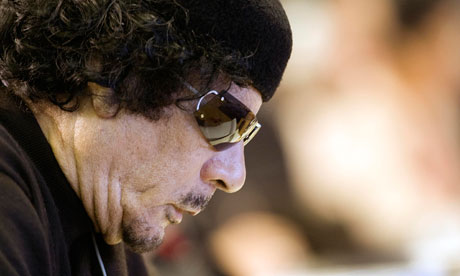Gaddafi's bounty hunters are up against history
It's no surprise the Libyan rebels are offering a £1m cash reward for the capture of Gaddafi, but such moves are rarely successful

Muammar Gaddafi has a £1m bounty on his head. Photograph: Alessandro Bianchi/Reuters
"The matter won't come to an end, except when he's captured dead or alive," the head of Libya's national transitional council, Mustafa Abdul Jalil, declared on Wednesday, referring to apparently deposed dictator Muammar Gaddafi. During a press conference in the opposition stronghold of Benghazi, Jalil stressed: "We fear mayhem and destruction from him because these are his values, upbringing and practices." To expedite Gaddafi's apprehension, Jalil announced an association of Libyan businessmen had offered a reward of 2m Libyan dinars, or about £1m, to anybody who captures the strongman.
It is not surprising that the Libyan rebels are using cash as a weapon against Gaddafi: bounties are inextricably linked with the history of strategic manhunts. On 3 May 1886, more than a century before a $25m reward was offered for information on al-Qaida mastermind Osama bin Laden's whereabouts, the US House of Representatives introduced a joint resolution "authorising the President to offer a reward of twenty-five thousand dollars for the killing or capture of Geronimo", the Apache war captain whose escape from a reservation in Arizona in 1885 created mass hysteria in the American south-west, and who had eluded US cavalry hunting him in northern Mexico for almost a year.
The size of the bounty has even come to reflect either the prestige or threat represented by the targeted individual. After the fall of Baghdad, coalition officials announced a $25m reward for information either proving Saddam Hussein's demise or leading to his capture, as well as a $15m reward for each of his sons. In July 2004, the reward for Abu Musab al-Zarqawi's capture was raised from $10m to $25m, signifying that he posed as great a threat to US interests as Bin Laden. Conversely, when Unosom II offered a $25,000 reward for the capture of Somali warlord Muhammad Farah Aideed in 1993, his Habr Gidr clansmen were insulted by the paltry sum and countered with a $1m reward for the capture of UN envoy Jonathan Howe, the then UN special representative for Somalia.
Yet despite their reoccurrence, bounties rarely produce decisive results in strategic manhunts. Congress's proposed reward for Geronimo had no effect on the successful conclusion of the manhunt, as his dwindling band tired of life on the run from the US cavalry's constant pursuit and willingly surrendered in September 1886. Saddam and Zarqawi were successfully targeted by intelligence gained from subordinates captured in special operations raids, not by Iraqi citizens seeking financial reward. Despite the hefty reward for Bin Laden, a senior US counterterrorist official told journalists that an al-Qaida operative betraying the Saudi mastermind would have been like "a Catholic giving up the pope". The intelligence trail that eventually led to Abbottabad began with detainee interrogations at Guantanamo and CIA "black" site prisons during which multiple al-Qaida operatives identified a courier by his nom de guerre rather than information directly related to Bin Laden or his Pakistani compound.
Bounties can even have a counterproductive effect on manhunts. After Panamanian dictator General Manuel Noriega's escape from US forces during the initial stages of Operation Just Cause in 1989, a $1m bounty for information leading to his capture was announced. Reports of Noriega sightings quickly flooded into the intelligence network, and analysts had significant difficulty trying to separate truth from falsehood.
The hunts for Noriega and Aideed offer arguably the most relevant precedents for the search for Gaddafi. In Mogadishu, America's most elite special operations forces could not penetrate Somalia's interwoven clans and tribes to gain intelligence on Aideed's whereabouts. Using an agent outside his own clan territory might render him suspect, and using an agent from within his own clan risked disinformation. Conversely, US forces specifically targeted loyal units of the Panamanian defence force at the outset of that invasion, and given that Noriega had spent the previous decade violently oppressing Panama's citizens, the pock-marked strongman had no other support network to fall back upon for sanctuary. Consequently, he barely reached the temporary safe haven of Panama City's Papal Nunciature before his chief bodyguard betrayed his location to US forces.
Which path will the hunt for Gaddafi follow? The key question is whether Gaddafi will be able to withdraw someplace where the local population is supportive. Did he make it through the miles of tunnels under his Bab al-Aziziya compound to areas controlled by tribal loyalists, such as Sirte. If so, a prolonged hunt may result. Conversely, in the comparatively cosmopolitan environment of Tripoli, it is unlikely that Gaddafi will be able to remain hidden for long as his overthrow appears increasingly inevitable and regime loyalists seek to save their own skins. Hence, the national transitional council's offer of amnesty for past crimes for any member of the strongman's inner circle who betrays him may be critical.
Either way, history suggests Libya's human terrain will likely prove more decisive in the hunt for Gaddafi than the prospect of a financial windfall.
No comments:
Post a Comment